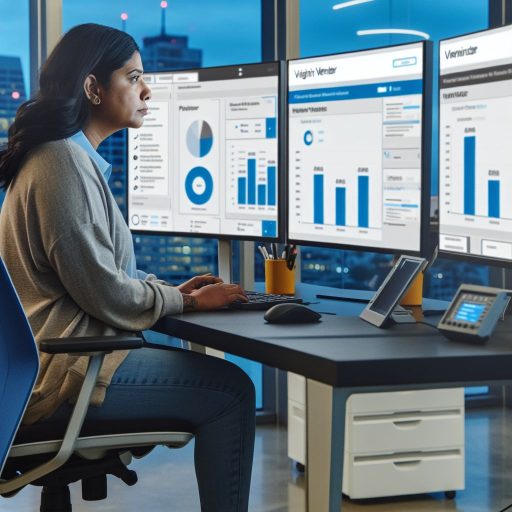Introduction:
IT risk management is crucial in today’s digital landscape due to the increasing cyber threats.
Organizations face security breaches and data compromises, highlighting the need for a robust risk framework to protect sensitive information.
Understanding IT Risk Management:
IT risk management is the process of identifying, assessing, and prioritizing risks related to information technology assets.
It is crucial for protecting organizational assets, maintaining operations, and ensuring data confidentiality and integrity.
This involves recognizing potential threats, evaluating their likelihood and impact, and implementing controls to reduce risks to an acceptable level.
IT risk management helps organizations comply with regulations such as GDPR, HIPAA, and industry standards like ISO 27001 by addressing security vulnerabilities.
Building a Robust Risk Framework:
- Define objectives, scope, roles, responsibilities, and methodologies for managing IT risks effectively.
- Conduct risk assessments to identify potential threats, vulnerabilities, and impacts on IT systems and assets.
- Implement controls, safeguards, and security measures to reduce the likelihood and impact of identified risks.
- Continuously assess the effectiveness of risk management controls, update risk assessments, and adjust mitigation plans as needed.
- Keep stakeholders informed about risk management activities, issues, and remediation efforts to ensure transparency and accountability.
Components of a Robust Risk Framework:
- Key Elements of a Comprehensive Risk Framework:
- Importance of Policies, Procedures, and Controls:
- Need for Regular Audits and Reviews:
Risk assessment, risk treatment, and risk monitoring are essential components.
Having well-defined policies, procedures, and controls is crucial for managing IT risks effectively.
Regular audits and reviews are necessary to ensure the framework remains up to date and effective.
Key Elements of a Comprehensive Risk Framework:
A comprehensive risk framework comprises several key elements that work together to identify, assess, mitigate, and monitor IT risks within an organization.
Risk Assessment:
Risk assessment involves identifying potential risks, analyzing their likelihood and impact, and prioritizing them based on their significance to the organization.
Risk Treatment:
Once risks are identified and assessed, organizations need to determine the most appropriate way to address them, whether through risk avoidance, mitigation, transfer, or acceptance.
Risk Monitoring:
Continuous monitoring of risks is essential to track any changes in the risk landscape and ensure that mitigation strategies are effective in reducing exposure to potential threats.
Importance of Policies, Procedures, and Controls:
Establishing and enforcing policies, procedures, and controls is fundamental in managing IT risks efficiently and effectively.
Policies:
Clear and concise policies set the tone for risk management practices, outlining the organization’s approach to identifying, assessing, and addressing IT risks.
Procedures:
Transform Your Career Today
Unlock a personalized career strategy that drives real results. Get tailored advice and a roadmap designed just for you.
Start NowProcedures detail the steps that need to be followed to implement the policies effectively, providing a roadmap for managing risks in a consistent and systematic manner.
Controls:
Controls are mechanisms put in place to mitigate risks and ensure compliance with the established policies and procedures, helping to safeguard critical IT assets and data.
Need for Regular Audits and Reviews:
Regular audits and reviews are critical to ensuring that the risk framework is up to date, effective, and aligned with the evolving IT landscape.
Audits:
Audits provide an independent evaluation of the risk management processes and controls, identifying any gaps or weaknesses that need to be addressed to enhance the overall effectiveness of the framework.
Reviews:
Regular reviews of the risk framework help organizations stay agile and responsive to changing threats, ensuring that risk management practices remain relevant and resilient in the face of emerging risks.
Learn More: Common Pitfalls in Enterprise Architecture and How to Avoid
Implementing IT Risk Management Strategies:
Common IT risks include data breaches, malware attacks, and system failures.
Organizations can address these risks through risk transfer, avoidance, and acceptance.
Technology solutions like encryption, firewalls, and intrusion detection systems help mitigate IT risks.
When it comes to IT risk management, organizations need to be proactive in identifying and addressing potential threats.
By understanding the common risks associated with information technology, companies can develop strategies to mitigate these risks and protect their assets.
Common IT Risks:
Data breaches are a significant concern for organizations, as they can lead to the exposure of sensitive information and damage the company’s reputation.
Malware attacks, such as viruses and ransomware, can also cause disruptions to business operations and result in financial losses.
In addition, system failures, whether due to hardware malfunctions or software glitches, can impact the availability and reliability of critical IT systems.
Risk Management Strategies:
To effectively manage IT risks, organizations can employ various risk management strategies.
Risk transfer involves transferring the risk to another party, such as through insurance or outsourcing certain IT functions.
Risk avoidance entails avoiding activities or investments that could expose the organization to unnecessary risks.
Transform Your Career Today
Unlock a personalized career strategy that drives real results. Get tailored advice and a roadmap designed just for you.
Start NowRisk acceptance means acknowledging the risks and their potential impact while preparing contingency plans to mitigate adverse outcomes.
Role of Technology Solutions:
Technology solutions play a crucial role in mitigating IT risks.
Encryption helps protect data by converting it into a secure format that can only be accessed with the appropriate decryption key.
Firewalls act as a barrier between a company’s internal network and external threats, filtering out malicious traffic and preventing unauthorized access.
Intrusion detection systems monitor network traffic for suspicious activity and alert administrators to potential security breaches.
By integrating these technology solutions into their IT infrastructure, organizations can enhance their overall security posture and minimize the impact of potential risks.
It’s essential for companies to continually assess their risk exposure, update their risk management strategies, and invest in robust technology solutions to safeguard against emerging threats in the ever-evolving landscape of IT risk management.
See Related Content: Importance of Ethics in Machine Learning Engineering
Building a Risk-Aware Culture:
Building a risk-aware culture is essential for the overall success and sustainability of an organization.
By fostering a culture of risk awareness, organizations can better identify, assess, and mitigate potential risks before they escalate into major issues.
Emphasizing the Importance of Creating a Culture of Risk Awareness
Creating a culture of risk awareness means that every employee understands the role they play in identifying and managing risks.
It involves instilling a sense of responsibility and accountability for risk management throughout the organization.
Employees need to recognize that risk management is not just the responsibility of a select few individuals or departments within the organization.
It is a collective effort that requires everyone’s participation.
When each employee is aware of the risks associated with their roles and activities, they can take proactive measures to prevent potential threats.
Training and Education Programs for Understanding IT Risk Management
One of the most effective ways to build a risk-aware culture is through training and education programs.
These programs help employees understand the significance of IT risk management and how it directly impacts the organization’s overall success and reputation.
By providing employees with the knowledge and tools to identify and respond to risks effectively, organizations can empower their workforce to contribute to a proactive risk management approach.
Training programs should cover essential topics such as identifying vulnerabilities, assessing potential threats, and implementing risk mitigation strategies.
By investing in continuous education and skill development, organizations can ensure that their employees are equipped to handle evolving risks in today’s dynamic IT landscape.
Transform Your Career Today
Unlock a personalized career strategy that drives real results. Get tailored advice and a roadmap designed just for you.
Start NowThe Role of Senior Management in Promoting Proactive Risk Management
Senior management plays a crucial role in promoting a proactive approach to risk management and fostering a culture of accountability within the organization.
Leaders need to set the tone for risk awareness by demonstrating their commitment to prioritizing risk management initiatives and encouraging open communication about potential risks.
By actively engaging with employees at all levels and soliciting feedback on risk-related issues, senior management can create a culture of transparency and trust.
This allows for effective risk identification and mitigation.
When employees see that senior leaders are invested in risk management efforts, they are more likely to take risks seriously.
They will follow suit in prioritizing risk management within their own roles.
Learn More: Networking Essentials for Systems Administrators

Continuous Improvement and Adaptation:
Organizations must continuously monitor and assess their IT risk environment.
Adapting risk management strategies is crucial to address new and evolving threats effectively.
Risk intelligence and threat monitoring play a vital role in keeping organizations ahead of potential risks.
Continuous monitoring and assessment of the IT risk environment are essential for organizations to stay proactive and prepared.
By regularly evaluating the landscape of potential risks, organizations can identify vulnerabilities, gaps, and emerging threats that may impact their operations.
Adapting risk management strategies is imperative in the ever-changing IT landscape.
As technology and threats evolve, organizations need to adjust their approach to managing risks accordingly.
By being flexible and adaptive, organizations can enhance their resilience and ability to mitigate potential risks effectively.
Risk intelligence and threat monitoring are critical components of a robust risk management framework.
By leveraging advanced tools and technologies, organizations can gather real-time insights into emerging threats and vulnerabilities.
This proactive approach enables organizations to stay ahead of potential risks and take preventive actions to mitigate them.
Furthermore, threat monitoring allows organizations to identify patterns, trends, and potential indicators of cyber threats.
By analyzing and interpreting threat intelligence, organizations can make informed decisions and prioritize their risk mitigation efforts effectively.
Transform Your Career Today
Unlock a personalized career strategy that drives real results. Get tailored advice and a roadmap designed just for you.
Start NowThis proactive approach empowers organizations to respond promptly to emerging threats and protect their assets and data from potential harm.
Continuous improvement and adaptation are essential principles in building a robust risk management framework.
By emphasizing the importance of monitoring, adapting, and leveraging risk intelligence, organizations can strengthen their resilience and effectively manage IT risks in a dynamic and ever-evolving environment.
Find Out More: Key Skills for a Successful Technical Account Manager
Importance of Involving Key Stakeholders
Key stakeholders, such as executives, IT teams, and external auditors, bring valuable insights.
Their involvement ensures a holistic view of the organization’s risk landscape.
Stakeholders provide diverse perspectives that help in identifying potential risks.
Executive buy-in is crucial for allocating resources and implementing risk management strategies.
Collaboration and Communication Among Stakeholders
Effective collaboration fosters a culture of shared responsibility for risk management.
Open communication channels enable stakeholders to share concerns and insights proactively.
Regular discussions help in aligning risk management efforts with business objectives.
Collaborative risk assessments lead to a more thorough understanding of potential risks.
Tips for Engaging Stakeholders in Risk Management
Provide clear guidance on stakeholders’ roles and responsibilities in risk management.
Encourage active participation by organizing regular meetings and workshops.
Seek feedback from stakeholders to continuously improve the risk management process.
Develop training programs to enhance stakeholders’ knowledge of risk management principles.
After delving into the intricacies of IT risk management and the importance of a robust risk framework, it is evident that proactively managing IT risks is crucial for safeguarding organizational assets and reputation.
By investing in creating a comprehensive risk framework and fostering a culture of risk awareness, organizations can better protect themselves against cyber threats and security breaches.
The key points discussed highlight the necessity of taking a proactive approach towards IT risk management.
Organizations must recognize the ever-evolving nature of cyber threats and implement strategies to mitigate potential risks effectively.
Transform Your Career Today
Unlock a personalized career strategy that drives real results. Get tailored advice and a roadmap designed just for you.
Start NowBy prioritizing risk management, businesses can strengthen their resilience in the face of technological vulnerabilities and ensure the longevity of their operations.
It is essential for organizations to view IT risk management as a strategic investment rather than a reactive measure.
Building a robust risk framework and promoting a culture of risk awareness will fortify the security posture of organizations.
These measures will enable them to navigate the digital landscape with confidence.
Embracing a proactive mindset towards IT risk management is crucial for sustaining business continuity and safeguarding against potential threats in an increasingly digital world.
Additional Resources
Cybersecurity Best Practices | Cybersecurity and Infrastructure …




